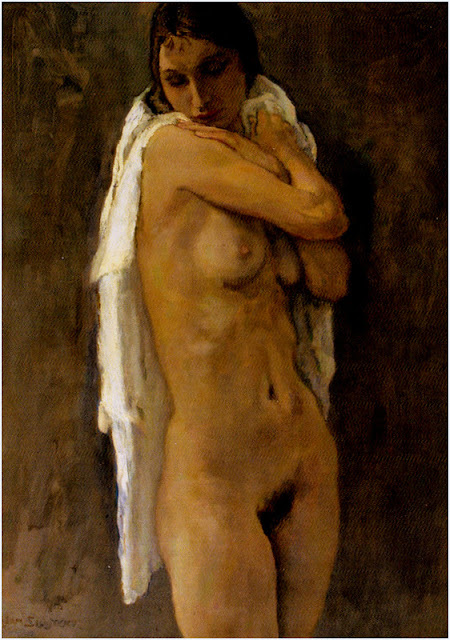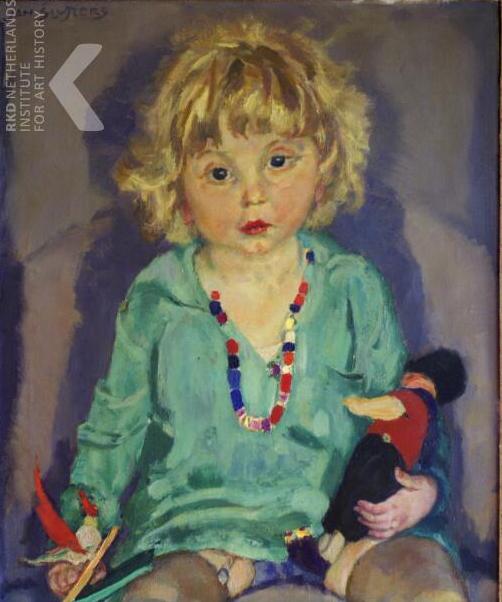 |
| Jan Sluijters (1881-1957), Standing Nude with White Drapery, 1935, Oil on Canvas, 45.7 by 32.3 in., Private Collection |
 |
|
Still Life with Standing Nude, 1933, Oil on
Canvas, 55.1 by 45.7 in., Private Collection
|
 |
|
Portrait of Greet Van Cooten,
the Artist’s Wife, Oil on Canvas, Dordrechts Museum, Netherlands
|
 |
| Dr. Floren Marinus Wibauthuis (1859-1936), 1932, Stedelijk Museum, Amsterdam |
 |
| N.H. ter Kuile and his wife, W.H. ter Kuile-Scholten, 1930, Oil on Canvas, 69.4 by 50 in., Rijksmuseum Twenthe, Enschede, Netherlands |
 |
|
Half-Naked (wife of the
artist), ca. 1912, Oil on Canvas, 50.2 by 37.6 in.,
Rijksmuseum Twenthe, Enschede, Netherlands
|
 |
| Adam and Eve, 1914-1916, Oil on Canvas, 69 by 79 in., Rijksmuseum Twenthe, Enschede, Netherlands |
 |
| Portrait of a girl, 1935, Oil on Canvas, 31.5 by 23.8 in., Private Collection |
 |
| Portrait of Esther, 1940, Oil on Canvas, 23.6 by 19.7 in., Private Collection |
 |
| Flowers in a White Vase, 1935, Oil on Canvas, 46 by 41.3 in., Private Collection |
 |
| Standing Male Nude, 1904, Oil on Canvas, 35.4 by 23.6 in. |
 |
| Seated Female Nude, Oil on Board |
 |
| The Artist in his studio |
I instantly fell in love with the painting above titled Standing Nude with White Drapery when
I saw it in an auction catalog a couple of years ago. The artist’s sensitive, skillful depiction of
a woman’s body, in a pose completely free of artifice but sensual as can be, with
subdued natural light caressing the model’s lissome figure, was sublime. What a marvelous figure painting. I wanted desperately to paint that picture
myself. I had no desire to copy it, of
course. But I wanted to get the same evocative
feeling of ethereal feminine beauty in a nude figure painting of my own.
The graceful pose was perfect for this Dutch model with a Modigliani-like
figure. And oh, melancholy me, years ago
I knew a Dutch woman who resembled her very much. When I first saw this painting, I had been
drawing a model in the sketch group I frequent who had the same kind of figure
and emanated a similar statuesque serenity.
She would be ideal for my picture.
So this transcendent painting I envisioned was buzzing
around in my head for some time before I woke up and remembered who I was and realized
it was just another one of my many impossible dreams. It was, for want of a more probing disquisition,
hopeless. I’m nothing but an old painter
of modest still lifes -- mere bagatelles.
I have no money to hire models, no connections in the art world, and
lack the persuasive skills necessary to get people to pose for me for nothing,
as I may have already mentioned once or twice in previous musings. But it’s true and bears repeating until the
cows come home. Personal failures and
failings are a lot more fun to recount than successes any day, and doing so
always cheers me up.
Anyhow, creating large figure paintings in my tiny, jam-packed
home studio in a pre-war apartment building on Manhattan’s fashionable Upper West Side is
extremely challenging and nearly always unrewarding, despite some conciliatory words
from the sitters after they have been inconvenienced for a few hours, with
nothing much to show for their discomfort.
Not being able to paint my own version of this wonderful
painting was a huge disappointment at the time.
But the most important thing was that I now knew about this painting, and
it immediately found a place in my heart alongside all the other great
paintings I admire. I chanced upon it in
a Christie’s Amsterdam catalog published
for an auction of 20th Century Art in December of 1999 that I picked
up at a used bookstore in my neighborhood.
I suspect that the model for the painting was Greet Van Cooten (1885-1967). The painter was Greet’s husband, the
much-celebrated, somewhat controversial and hugely talented and prolific Dutch
painter Jan Sluitjers (1881-1957).
Greet was his second wife. Sluitjers won the Prix de Rome for an academic
painting he created while studying at the Rijksakademie in Amsterdam in 1904 and married Bertha Langerhorst that year. They divorced in 1910 and he married Greet
in 1913. Sluijters was a very lucky man
to have a wife like Greet who would double as a steadfast, reliable model for
many of his figure paintings. And he got
a few paintings out of Bertha, as well, before they parted company. In addition, it seems that the quintessential
“model as mistress” theme was an important element in Sluijters’ artistic life.
Johannes Carolus
Bernardus (Jan) Sluijters (sometimes
spelled Sluyters) was particularly keen on painting nude figure studies of
women and portraits of women and girls of all ages and from all walks of life. A discerning retrospective exhibition of his
work at the Kunsthal in Rotterdam in 2003 was titled Women! Muse, Model and Lover.
Sluijters was a peripatetic modernist
who was comfortable working on the fringes of many of the post-impressionist
styles gaining favor with his contemporaries, but he never completely abandoned
his early academic training, always displaying some excellent drawing and sense
of traditional design in his stylistic adventures. He was considered a pioneer of various
post-impressionist movements in the Netherlands,
including fauvism and colorful expressionism. He also painted loads of landscapes
and still lifes, often in a loose, impressionistic manner. It seems he could paint anything he wanted in
any style he chose, with amazing skill. He
was free to do so because he had first learned how to paint and draw accurately
with the best of the academicians. His
later creative explorations must have seemed like child’s play to him. And it seems he never set his brushes down to
eat lunch or take a nap.
The exhibit in Rotterdam
displayed more than 100 paintings, prints and drawings of
his impressionistic, luminist, cubist and expressionist phases. It was said to give a pretty complete picture
of Sluijters' artistic development, from the book bindings and illustrations early on, through his brief but brilliant academic
painting years, and ending with the “colorful, lush paintings” he created from
about 1910 until his death 47 years later, at the age of 76. Some of his nudes scandalized the Dutch
public, with one reviewer comparing the women to “vampires.” His portrait of a woman with a big grin and
huge red lips caused another reviewer to remark, “Her
red mouth is the forbidden fruit.”
When I started to look for his work
on the Internet, I was absolutely blown away by the enormity of his recorded
output, particularly in evidence on the RKD Netherlands Imagebase, which
displays 2,048 images of his artwork on 41 pages of a digital catalogue
compiled over many years of research.
What an immense task. After about
10 pages of 50 images each, I was worn out and abandoned my search to find the
perfect paintings to illustrate this blog post. I gather that most of his artwork is in
private collections or museums in Europe.
Every one of his works has
something interesting to offer for any serious art lover. What an imaginative figurative artist he was.
Everything seemed to interest his nimble artistic mind, not just the female
form divine. He seemed to float lightly
across the entire post-impressionist landscape, producing gems wherever he landed.
Someone at the RKD Netherlands
Imagebase wrote that Sluijters was
a painter through and through. With vigorous
movements of the brush and a palette of bright and sharply contrasting colours he immortalized beautiful women, sweet children, sundrenched landscapes
and exuberant flower still lives on his
canvases. Sluijters began his
career as an experimenter, trying out
practically every ‘-ism’ of his time. In the course of his
life he gradually toned down his style to a more moderate but highly successful
combination of expressionism and realism. Working steadily he produced no fewer than 1500
paintings.
Sluijters was nicknamed the “painter-beast” by his
contemporaries because of his rugged, robust appearance and insatiable appetite
for painting. He was no dreamer.